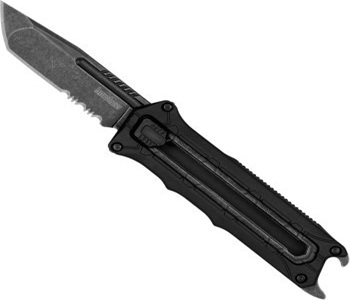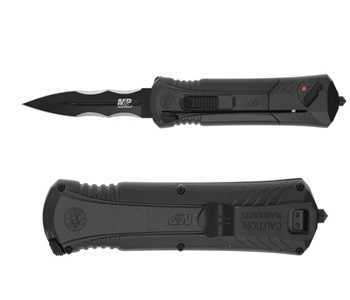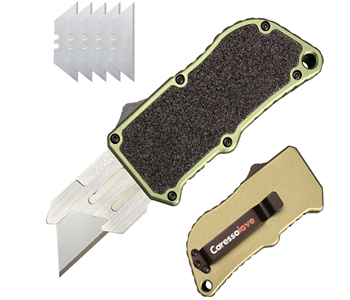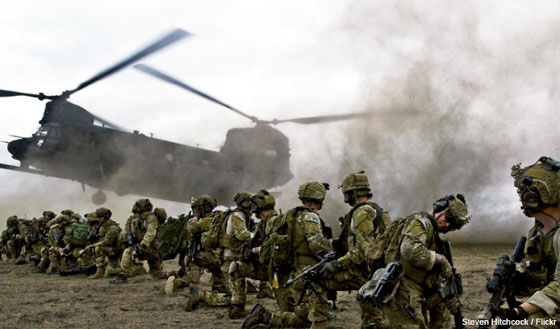Best OTF Knife Under $100

You’re not here for pretty Instagram flexes. You’re here because you want a knife that will actually work when it matters — not one of those shelf queens that crumbles the moment grit, sweat, or urgency shows up. OTF knives (out-the-front) look cool, deploy fast, and sell like hot gossip — which makes them a magnet for low-quality junk dressed in tactical theater. This guide rips the fluff away, tells you the real stuff to look for, and gives a hard-talking take on three affordable options under $100.
Stop buying hype: the checklist that matters
Listen: specs and marketing blurbs lie. Sellers will talk about “tactical blades” and “military-grade” finishes until your eyes glaze over. Here’s the checklist that separates tools from toys.
Manual vs Automatic – pick your poison wisely
Automatic OTFs look badass, but they’re also more complex. Springs, small parts, and aggressive deployment mechanisms can fail or get jammed with dirt. For under $100, a manual OTF (a simple slide that pushes the blade out) often wins for reliability. The trade-off is speed, not survivability.
Steel – named > vague
If the listing says “stainless alloy” and nothing else, assume the blade will be a pain. Look for named steels: 8Cr13MoV, AUS-8, 440C, or similar. These are budget steels that sharpen easily and hold an edge reasonably. Carbon steel can be great, but it rusts if you don’t baby it — not ideal if you want a low-maintenance tool.
Mechanism & fit-and-finish – the actual deal-breaker
The blade material matters, but the mechanism determines whether the knife will still work in three months. Feel matters. A smooth, solid slider with little wobble beats shiny marketing. A knife that rattles or has a loose clip is a future nuisance.
Blade shape & length
For EDC and most practical uses, avoid extreme tanto points unless you know you need them. A drop or spear point with a 3″–3.5″ blade is versatile. Serrations have their uses for rope and fibrous material, but they ruin easy sharpening.
Handle material & ergonomics
Aluminum, stainless, or glass-filled nylon — each has trade-offs. Metal feels premium and resists wear; GFN keeps the weight down. But the shape and grip are more important than material: a well-shaped GFN handle beats an uncomfortable aluminum slab.
Parts, serviceability, and warranty
Cheap knives often die because a tiny spring snaps or a clip strips. Can you get replacement blades? Does the brand offer a warranty or parts? If the seller is anonymous and the warranty is vapor, that’s a red flag.
Safety & legality
OTF = legal minefield in many places. Know your local laws before you buy or carry. And learn safe handling: a careless hand on an automatic OTF is a fast ticket to a trip to urgent care.
Red flags
No steel listed, no seller history, unrealistic lifetime warranty from a no-name company, or a product page with seven different, conflicting specs. If it smells like a scam, it probably is.
The real-world picks – what works under $100
You gave three picks. I stripped the fluff and wrote the straight truth so you can decide without falling for the same tricks every buyer falls for.
Kershaw Interstellar – the practical winner
 Why it matters: it’s a manual-slider OTF with a named budget steel that’s predictable and easy to sharpen. The mechanism is simpler and therefore less likely to fail in real use. It’s not trying to look like Rambo; it’s trying to not break.
Why it matters: it’s a manual-slider OTF with a named budget steel that’s predictable and easy to sharpen. The mechanism is simpler and therefore less likely to fail in real use. It’s not trying to look like Rambo; it’s trying to not break.
Why you’d buy it: dependable blade steel, simple mechanism, practical features like a low-profile clip. Why you might skip it: handle materials are budget-tier and it’s not the flashiest knife in the room.
My take: if you need one OTF under $100 that you’ll actually rely on instead of showing off, this is the most honest play.
Smith & Wesson MPOTF10 – the tactical-looking compromise
 Why it matters: branded product, clear specs, and a blade steel that’s workable. It leans into the tactical aesthetic — glass breaker, serrated options, safety locks — all the theater without pretending to be premium metalwork.
Why it matters: branded product, clear specs, and a blade steel that’s workable. It leans into the tactical aesthetic — glass breaker, serrated options, safety locks — all the theater without pretending to be premium metalwork.
Why you’d buy it: recognizable brand backing and clear, named steel specs. Why you might skip it: mechanisms on budget “tactical” models can still be average; expect decent performance but not miracles.
My take: a defensible choice if you want tactical looks and a real warranty behind the product. Still, don’t expect it to survive hard abuse like a pricier name-brand knife.
Caresslove Aviation Aluminum utility knife – useful, not tactical
 Why it matters: this is a utility cutter disguised in a compact body. Replaceable blades, cheap, and excellent for cutting boxes, straps, and tape. It is not a tactical OTF and should not be treated like one.
Why it matters: this is a utility cutter disguised in a compact body. Replaceable blades, cheap, and excellent for cutting boxes, straps, and tape. It is not a tactical OTF and should not be treated like one.
Why you’d buy it: it’s the cheapest, easiest to maintain, and replaceable-blade design makes it perfect for work. Why you might skip it: it’s not meant for stabbing, defending, or any tactical scenario.
My take: buy one for the toolbox and stop pretending it’s an answer to anything but cardboard.
Final, blunt buying advice
If your priority is reliability and actual use, take the manual-slider option. If you want the tactical look and a brand name with a warranty, the branded automatic-style option is the compromise. If you’re doing trades or cut-heavy work, buy the replaceable-blade utility cutter and stop pretending it’s a tactical blade.
Don’t chase aesthetics. Don’t buy a knife because the box art looks like a military poster. Buy the one that will still open and close when gunk, sweat, and urgency show up.
Knife = small piece of a bigger plan
Here’s the honest truth: a knife is a tool. It does not feed you, it does not purify water, and it won’t replace planning. In the bug-in guide wrote by a survival specialist, you learn how a knife fits into a layered readiness plan — food and water priorities, medical triage, household defense that doesn’t escalate into chaos, and daily-use contingencies that actually work.
If you want the rest — the 72-hour → 6-month blueprint that treats the knife like the useful small thing it is — grab the bug-in guide. It’ll teach you how to pair tools with a pantry, where to put redundancies, and how to turn a single-family home into a practical, livable fortress without turning into a paranoid caricature. Click the buy button, read the plan, and stop treating gear as the whole solution. Gear helps. Planning wins.
You may also like:
 The Knife In Rambo – Good For Survival Or Not?
The Knife In Rambo – Good For Survival Or Not?
9 Tools The Pioneers Carried With Them At All Times (video)
Common Tactical Knife Myths that Can get You Killed
How to Make Your Knife as Sharp as the Devil Himself
The Prepping Skill Nobody Talks About (That Could Save Your Life)
Read the full article here









